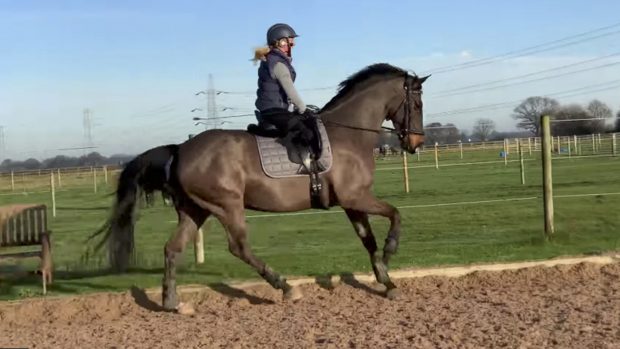P>Q: I’ve just bought a seven-year-old 15.3hh Warmblood mare for show jumping and dressage. Her schooling is going well and I’d like us to be able to perform a flying change so she can change legs in between fences. The closest I’ve got is to trot a few strides before striking off in canter on the other leg. Can you explain theaids for a flying change and do you have any other tips on perfecting this movement?
Debbie Moore replies: Horses do flying changes naturally from when they are foals. When we ride them we affect their natural balance.
To be able to teach your horse flying changes, you must firstly develop a good three-beat canter with your horse working through his back in a relaxed and supple manner. He should be straight and balanced, showing good self-carriage.
Changes should be taught when you are beginning to teach counter canter, and it is important to never make your horse feel as though he shouldn’t have changed if he does so without you asking.
Sadly, many riders make the mistake of over schooling the counter canter and some may even punish their horse for making a change without being asked. Then the horse misunderstands and starts to become tense and difficult to train.
In order to perform flying changes, it is important to be able to ride good transitions into and out of canter easily from walk and trot. Practise on a straight line transition. Walk into right canter, walk into left canter, walk and repeat.
It is better to have an experienced trainer ride the changes on your horse in the beginning as the timing of the aids is crucial to achieve clean ones. Then, once your horse understands, the trainer should be there to help you ride flying changes without confusing your horse.
A useful first exercise to teach the change is to make a walk to counter canter transition at the start of the long side of the arena.
At the half marker (B or E), half circle 20m across the arena in counter canter and invite your horse to change as he arrives at the track on the opposite side.
Straighten him and, as you bring your new outside leg back and apply pressure, make sure you put your new inside leg forward and think of keeping it off the horse.
This way you won’t use it and confuse him, which often happens when riders are learning.
Timing is crucial. The change should be asked for when the horse has three legs on the ground, just before the moment of suspension in the canter.
We use our inside leg on the horse in the rhythm of the canter – you’ll find you will automatically apply pressure at the same moment as you would for a change.
It is a common fault to panic and ask for the change too quickly, so think slowly, trying to use your legs in the same rhythm when you ask for the flying change.
Read more dressage training tips:


